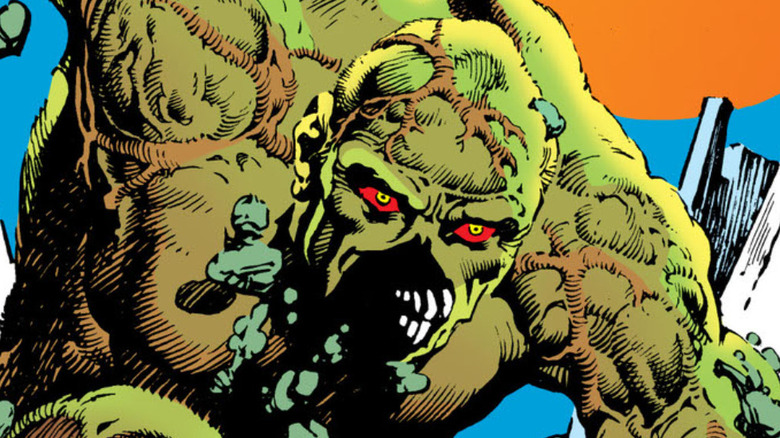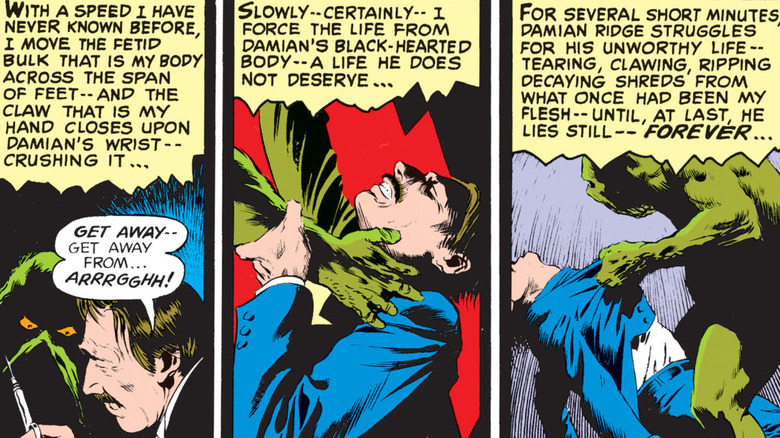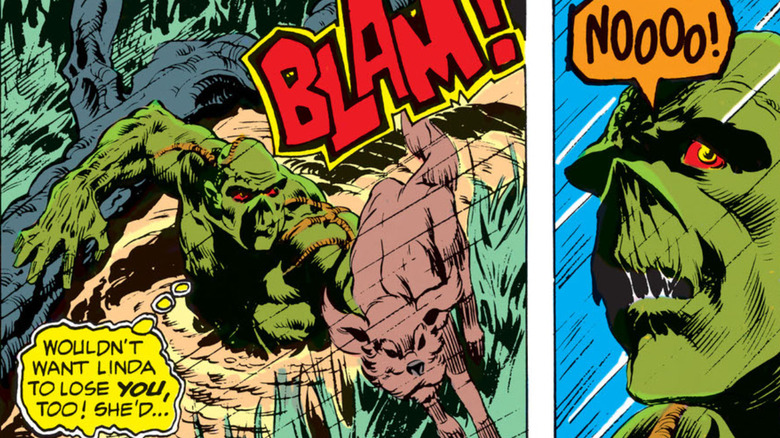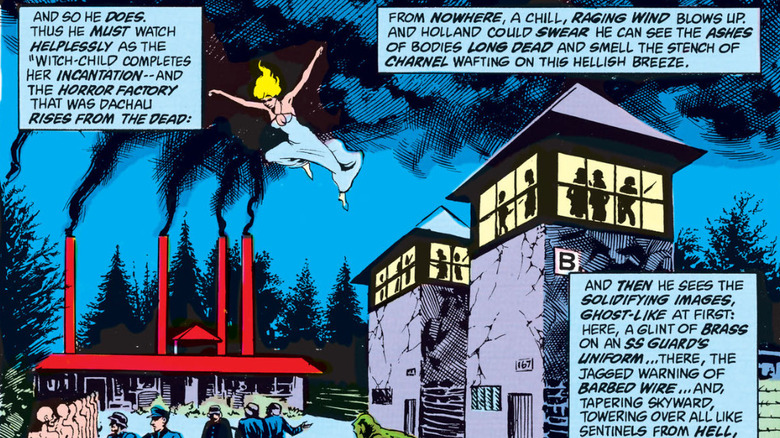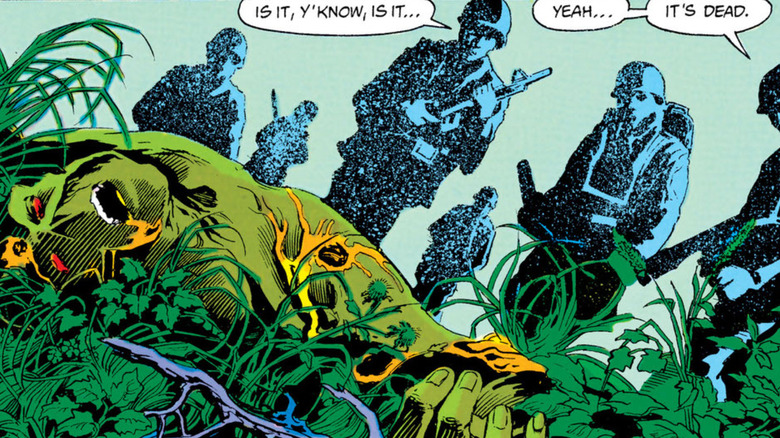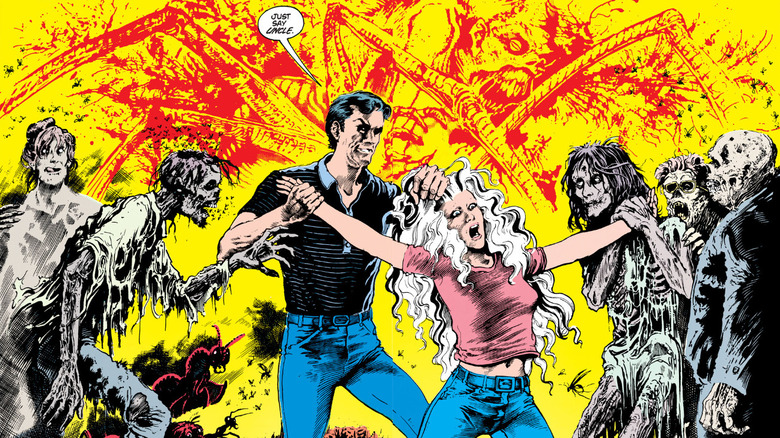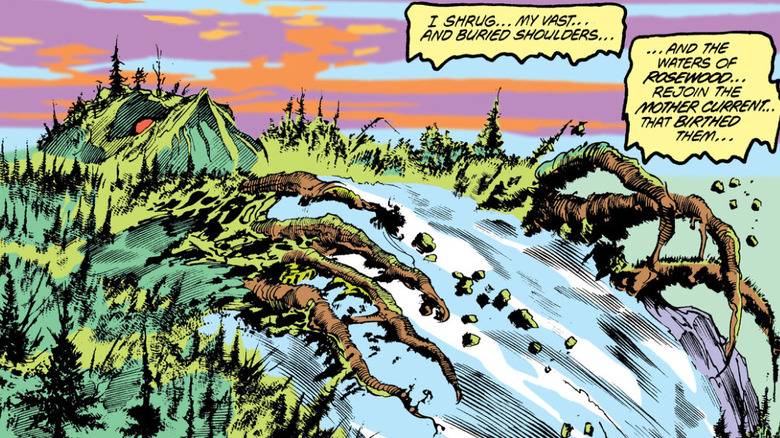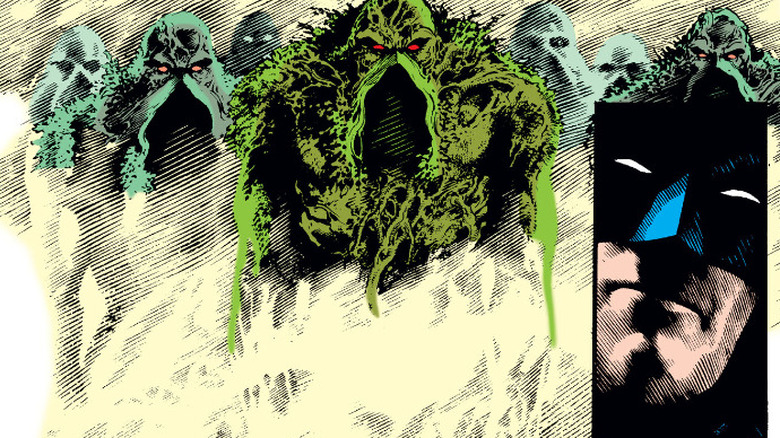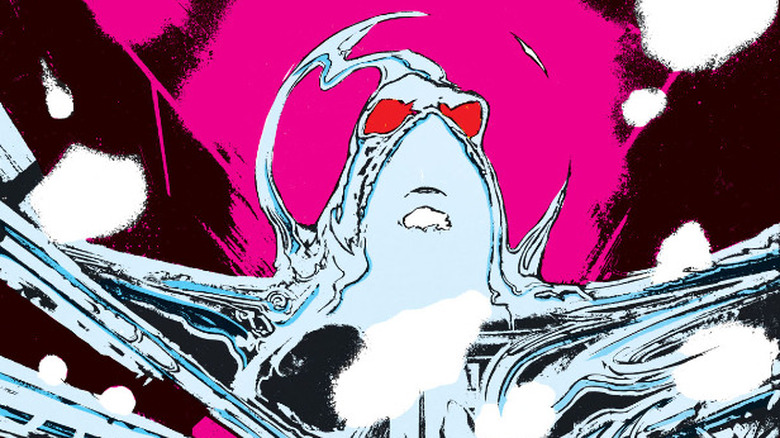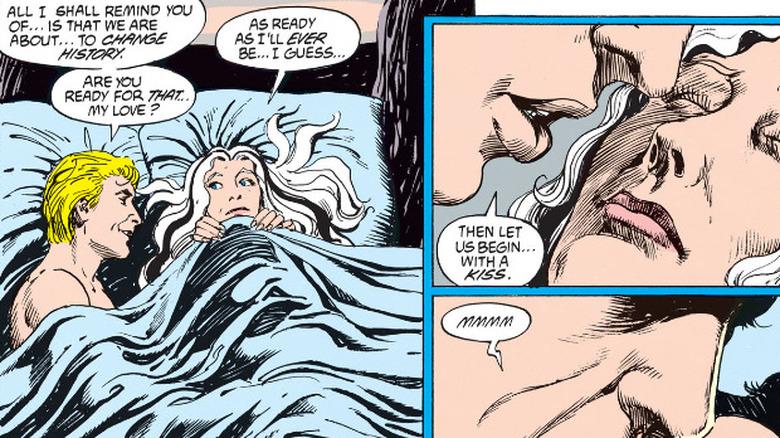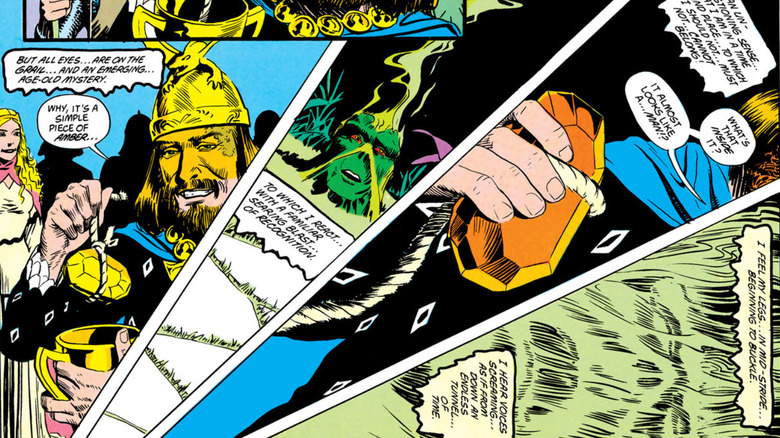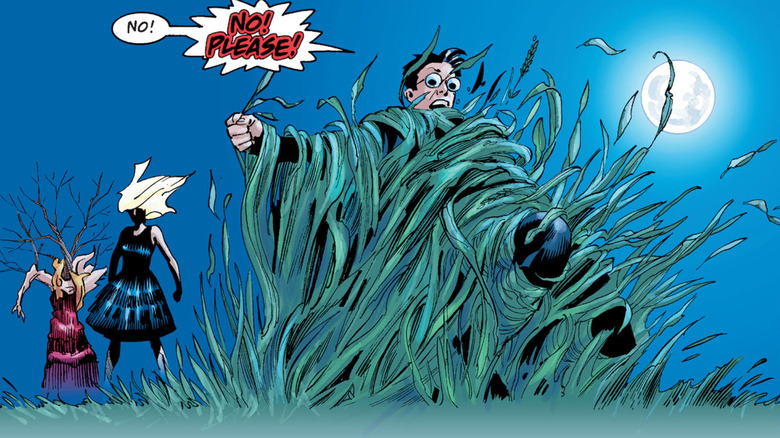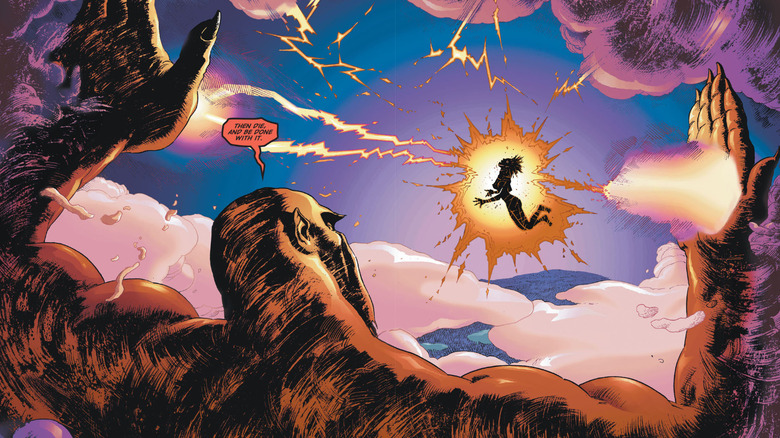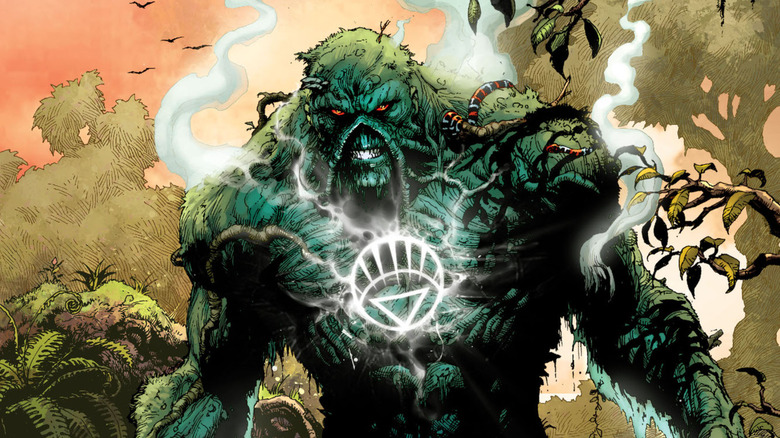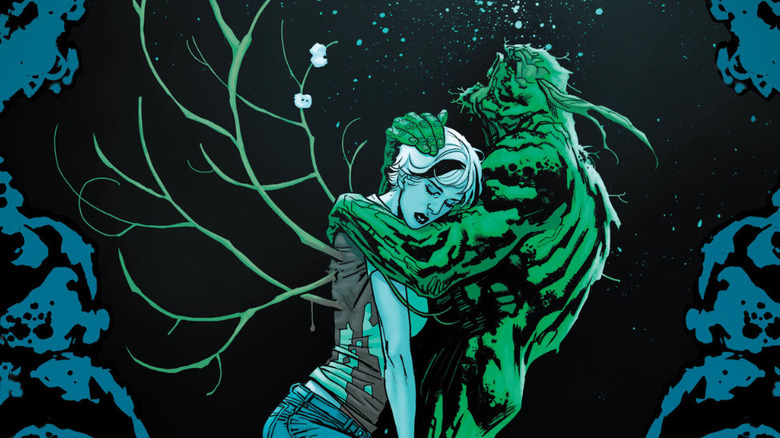The Dark History Of Swamp Thing
In April 1971, a short story by writer Len Wein and artist Bernie Wrightson appeared in the pages of the DC Comics horror anthology book "House of Secrets." It told the story of a man betrayed by his best friend; a man whose near-lifeless body was dragged out to the swamp and buried there, only to rise as a monstrous plant-like creature in order to take his revenge. The story was called "Swamp Thing," and it would prove massively influential, not only within the fictional world of DC Comics, but also within the comic book industry as a whole.
From its humble beginnings, "Swamp Thing" would spawn six distinct ongoing comic series, including the celebrated run that catapulted Alan Moore into superstardom, as well as the recent revival by award-winning creator Ram V. It also secured a crucial victory over the draconian Comics Code Authority by refusing to censor some of its darkest material. "Swamp Thing" has engaged with some very dark material over the years –- after all, at its roots, it's still a horror story. This is the history of the "Swamp Thing" comics as told through some of their most memorably controversial moments. Warning: These moments include death, religious iconography, and sexual assault. If that's not enough to scare you away, strap in for a spoiler-filled journey through the red and angry world of "Swamp Thing."
Swamp Thing begins with murder
The original Swamp Thing, introduced in "House of Secrets #92," bears only a passing resemblance to the character that would debut in his first ongoing comic a year later. His appearance is similar, but his name is Alex Olsen rather than Alec Holland, and his origin story is very different. Whereas Holland was famously blown up by criminal agents trying to steal his "bio-restorative formula," Olsen was blown up by his supposed best friend, Damian Ridge, who secretly coveted Olsen's wife, Linda. With Olsen out of the way, Ridge convinces Linda to marry him, but when she begins to suspect that her new husband is responsible for the death of her first one, Ridge realizes he has to kill her to keep his crime covered up. Just as he's about to do so, Olsen -– transformed into the Swamp Thing –- bursts in, disarms Ridge, and then proceeds to brutally murder him.
Now, granted, Ridge did mortally would Olsen with explosives, bury his body in the swamp, marry his wife, then try to kill her. He deserves some type of retribution. But it's unusual for a character who has become associated with the superheroic world of DC Comics to casually kill someone in their first appearance. Nor would it be that character's last murder. Indeed, "House of Secrets #92" was the start of Swamp Thing's violent tendencies.
Linda Holland gets fridged while Alec is rescuing a dog
The disparities between the tales of Alex Olsen and Alec Holland, who was introduced in "Swamp Thing #1" after the original short story was reworked by Wein and Wrightson, are so notable that a later issue felt the need to canonically clarify that Olsen was actually a different character who also happened to become Swamp Thing. One of the biggest differences is that Olsen's former wife, Linda, is alive at the end of the story — though she's terrified of the unrecognizable monster that has just killed her second husband — while Holland's wife (also named Linda) doesn't make it through the first issue. Like Alec, Linda is a biologist working on the bio-restorative formula, but she doesn't die in the explosion. Rather, she's killed after the fact, offscreen, by the same group of criminals trying to steal it. Alec had already risen as Swamp Thing and could conceivably have made it back in time to save her, but instead, he's busy rescuing her dog from the swamp, reasoning that she'd never forgive him otherwise. While that's a very sweet gesture on his part, we suspect that if she'd had the chance, Linda might have told Alec to let the dog go.
Not your older brother's Swamp Thing
The first "Swamp Thing" ran for 24 issues, but Wein and Wrightson had both left the book by issue #14. During their time, they sowed the seeds of Swamp Thing's regular supporting cast, including his most iconic nemesis, Anton Arcane, but their replacements weren't able to cultivate anything notable. The decline in quality led to "Swamp Thing" being canceled in 1976. However, in 1982, a "Swamp Thing" movie, written and directed by Wes Craven and starring Dick Durock and Adrienne Barbeau, was released. Anxious to capitalize on the renewed attention, DC revived the title, calling the second ongoing series "Saga of the Swamp Thing."
New "Swamp Thing" writer Martin Pasko clearly had little interest in Wein and Wrightson's supporting cast, and as a result, Swamp Thing's first major antagonist was not Anton Arcane, but rather a girl by the name of Karen Clancy whose efforts to destroy the world form the overarching plot of the series' first year. As it turns out, she's basically the Antichrist. If that wasn't enough, in "Saga of the Swamp Thing #10," Clancy arrives in Germany at the site of the infamous Dachau concentration camp and raises an army of Nazis from the dead.
Swamp Thing is dead; long live Swamp Thing
Pasko eventually did bring back Anton Arcane, but it was his last act in the series. Following the resolution of the Karen Clancy storyline, Pasko wrote only four more issues of "Saga of the Swamp Thing," in part due to creative disputes with new artists Stephen Bissette and John Totleben. He was also departing a sinking ship; "Saga of the Swamp Thing" had become one of DC's worst-performing titles and was close to being canceled for a second time. As a last-ditch effort, Wein, now an editor at DC, put the series in the hands of a promising British newcomer named Alan Moore.
Moore's first run on an American comic book proved to be a historic one, and he began his tenure in typical Alan Moore fashion: He killed the main character. Moore's first issue ends with Swamp Thing being riddled with bullets and falling dead to the ground, which is certainly a way to start things off. He followed that up with the famed "The Anatomy Lesson," retconning Swamp Thing's origin story and revealing that, instead of Alec Holland transforming into a plant, Swamp Thing was actually a sentient plant that believed it was Alec Holland (and that, incidentally, couldn't be killed with bullets). The reveal is based on science that doesn't hold up to modern scrutiny, but it was still brilliant, shattering Swamp Thing's sense of identity and establishing Moore as a legend in the making.
Moore cracks the code
From 1984 to 1987, Moore penned 45 issues of "Saga of the Swamp Thing," and as you'll see, he's responsible for several of the book's most notorious moments. One in particular, however, stands above all the rest, not only because of its brutal and disturbing storyline, but because of its ramifications for the comic book industry as a whole. The Comics Code Authority, an organization formed by comic book publishers for purposes of content regulation and censorship, had been preventing the distribution of any comic that didn't bear its seal of approval since 1954. It weakened over the next 30 years, but still maintained significant dominance over the industry — at least until "Saga of the Swamp Thing #29," entitled "Love and Death."
The disturbing content of this story can't be avoided –- in it, Anton Arcane returns from the dead and rapes his niece, Abigail Arcane Cable Holland, by possessing the body of her husband. Despite the gradual loosening of their grip, the CCA wasn't about to approve something like that, so Moore and his editor, Karen Berger, convinced DC Comics to release the issue anyway, without CCA approval. Shortly thereafter, DC stopped submitting "Saga of the Swamp Thing" to the CCA at all, and its continued commercial and critical success effectively rendered the organization toothless. There are numerous discussions to be had about how Moore chose to engage with a topic as violent as sexual assault, but the historic impact of "Love and Death" is beyond dispute.
Vampire genocide (and other stories)
Following the Arcane storyline (which culminated in "Love and Death's" mirror image, a psychedelic plant/human sex story called "Rite of Spring"), Moore's next major arc can be seen as beginning with "Saga of the Swamp Thing #37," the issue that introduces John Constantine, and ending with issue #50, coinciding with, but largely remaining parallel to, the industry-altering crossover event "Crisis on Infinite Earths." Informally referred to as "American Gothic," this storyline saw Swamp Thing's power as a plant elemental increase dramatically, a change that begins when he realizes he can use nature to travel around the country instantaneously. His abilities truly escalate in issue #39. Up against a community of aquatic vampires, Swamp Thing ultimately wins the day not by fighting them, but by shifting the entire landscape so that the still water that had been the vampires' home suddenly becomes running water, destroying them. Moore infuses the moment with unexpected sympathy for the vampires, who have only acted according to their nature and are being suddenly, cruelly wiped out. "American Gothic" goes on to deal directly with themes of sexism, racism, and drug use, and ends with Swamp Thing brokering a literal handshake between the abstract forces of good and evil.
Mr. Holland goes to Gotham
If "American Gothic" concludes with issue #50, the three subsequent issues are its epilogue, the capstone that sees Swamp Thing finally complete his long journey before immediately beginning a new one. After all, in the world of DC Comics, few things could be more fitting than a dark tour of the underbelly of America coming to an end in Gotham City.
While Swamp Thing has been away from his home territory of Louisiana, a muckraking journalist has discovered the relationship between Swamp Thing and Abigail Arcane. The public attention causes Abby to become the target of a harassment campaign, culminating in her arrest as a sexual deviant in Gotham. When the returning Swamp Thing discovers this, he declares war, using his newfound abilities to take over the entire city by literally swamping it in greenery. Of course, such an act draws the attention of Gotham's protector, the Dark Knight himself, Batman ... who is quickly and thoroughly beaten by Swamp Thing. The man who has an answer for everyone has none for the monster enveloping Gotham, turning the city into a primal paradise where industry has ground to a halt and the population trips on edible hallucinogens. Ultimately, Batman declares Swamp Thing to be "god-like" and admits that the only solution is to give in to his demands and free Abby.
In space, no one can swamp your thing
Naturally, no sooner are Swamp Thing and Abby reunited than Moore kills his protagonist once again (for the third time, in fact, since Swamp Thing's physical body was destroyed just before "American Gothic" in a two-issue story called "The Nukeface Papers"). This time, Swamp Thing's enemies find a way to disconnect him from "the Green," the elemental force that governs and encompasses the world's plant life, meaning that when he dies, his consciousness is flung into the vast reaches of space. This kicks off Moore's last arc in "Saga of the Swamp Thing," a final experimental flourish that sees the main character create and destroy his own macabre plant world, accidentally fuse with a planet of intelligent plants in an utterly grotesque body horror sequence, and, perhaps most memorably, encounter a massive biomechanical alien that falls in love with him and traps him in some sort of unknown (and unwilling) mating process. Say what you will about Alan Moore, but he certainly went out with a bang.
A sprout is born
Swamp Thing does, of course, make it back to Earth and once again reunite with Abby, sending Moore off on a heartwarming and positive note when he left the title in 1987, having definitively left his mark on American comics. After Moore's departure, "Saga of the Swamp Thing" was taken over by one of its regular artists, Rick Veitch. Though not in possession of Moore's weird genius, Veitch was intimately familiar with the book as it had existed under Moore, and he was able to take the reins without much interruption in tonal or narrative continuity. His arc with the most lasting consequences is the story of the Sprout, an unborn plant elemental created by the Green to be Swamp Thing's replacement while he was lost in space. Faced with the choice of killing the creature or retiring to become part of the motionless, eternal Parliament of Trees, Swamp Thing selects a third option: Finding the Sprout a human host. This is ultimately achieved when Swamp Thing possesses the body of John Constantine, which he then uses to impregnate Abby in a truly bizarre scenario that only works because of the consent of all involved. The product of this union is the couple's daughter, Tefé Holland, who would go on to become a major part of "Swamp Thing" in the years to come.
Stations of the crossover
Veitch's run on "Saga of the Swamp Thing" lasted two years, but his exit from the title was every bit as acrimonious as Moore's exit from DC Comics (and indeed, American comics as a whole). Veitch's final storyline was an ambitious one that saw Swamp Thing being continually sent back further and further in time thanks to a mystic piece of amber. His last published issue, "Fall of the House of Pendragon," took place in Camelot and saw the piece of amber appear in a cup that was clearly the Holy Grail. When Swamp Thing went back in time yet again in the next issue, Veitch intended for him to encounter Jesus Christ, an intentionally provocative choice. Veitch, however, was not Moore, and due to a variety of factors –- not least of which was the imminent release of the 1989 film "Batman" –- DC wasn't interested in taking any risks this time around. They refused to publish the issue, and Veitch quit the book in protest. The replacement story made it clear that the cup from the previous issue had never been the Holy Grail, and its writer, Doug Wheeler, would end up replacing Veitch as lead author of the series.
Tefé Holland is a murderous demon spawn
"Saga of the Swamp Thing" ran until 1996, with a succession of writers that included Nancy A. Collins, Grant Morrison, and Mark Millar, who essentially destroyed any possibility of narrative drama by having Swamp Thing become master of all elements on the planet. The characters lay dormant for more than three years, but in 2000, a third ongoing series began. Once again simply titled "Swamp Thing," this new comic was written by a nascent Brian K. Vaughan, who would go on to become known for his work on "Runaways," "Y: The Last Man," and "Saga," and its main character was Swamp Thing's daughter, Tefé. As it turned out, she was tainted by demon blood, and proved so dangerous that her parents ended up wiping her memory and giving her a new identity in hopes that she'd never discover who she really is. Of course, the truth comes out in explosive fashion. Upon discovering that her boyfriend is cheating on her with her best friend, she kills them both with her plant elemental abilities. That's only the beginning of her story. Tefé is widely expected to destroy the entire world someday, and while Vaughan's run ends after only 20 issues without answering the question of who she would ultimately become, her very existence is a blot of darkness on the history of "Swamp Thing."
Swamp Thing kills children
The next "Swamp Thing" ongoing series came in 2004, written first by Andy Diggle and later by Joshua Dysart. Not a terribly well-remembered comic, it returns to the original Swamp Thing as its protagonist and necessarily lowers his power level, narrowing its scope in the process and limiting the majority of its action to the swamps of Louisiana. However, it does contain a few notably dark moments, the darkest one being the conclusion of Diggle's first arc. With Swamp Thing having abandoned the part of him that was modeled after Alec Holland, he becomes a raging, unstoppable force of nature, and ends up killing Tefé in combat. Naturally, she's brought back right away. The act of killing her leads him to regain the Holland part of his personality, but it's still jarring to see the ostensible hero of the story murder his child in cold chlorophyll. Nor does it get any easier in Dysart's run, which features an issue in which Swamp Thing is forced to deal with the fact that he's accidentally killed a baby.
Swamp Thing kills everything (or at least tries)
After the conclusion of Dysart's run in 2006, Swamp Thing again took a seat on the sidelines. When he came back, things would be very different. As one of the flagship titles of the Vertigo imprint, which was written for mature audiences, "Swamp Thing" was never anything more than tangentially related to the more kid-friendly superhero narratives of DC. But as the 2010s came around, that relationship began to change, and DC started incorporating Vertigo characters into its fictional universe proper. Swamp Thing's turn came at the end of the 2010-2011 crossover event "Brightest Day," a sequel to the previous year's crossover, "Blackest Night," which had featured as its primary villain an elemental force of death called Nekron. "Brightest Day" reveals that Nekron had imprinted its personality on Swamp Thing, essentially erasing Alec Holland and making Swamp Thing want nothing more than to destroy all life. The solution? Obviously, resurrect the original Alec Holland, dead since "Swamp Thing #1," and make him the new Swamp Thing, charged with protecting life. Not only was Swamp Thing finally an official part of DC Comics, but he was now, at long last, the real Alec Holland, not a facsimile.
Swamp Thing kills Abby
The O.G. Holland didn't get a whole lot of time to enjoy that version of his existence. "Brightest Day" was followed immediately by another crossover, "Flashpoint," which led to the entire DC universe being overturned and rearranged as part of "The New 52." This new status quo featured a fifth "Swamp Thing" ongoing (the last until Ram V's run), penned by acclaimed "Batman" writer Scott Snyder. Snyder dug deep into "Swamp Thing's" considerable mythology, once again having Alec Holland become the Avatar of the Green. Snyder also introduced as his primary antagonist a primal force of decay known as the Rot, embodied by –- who else? –- Anton Arcane. But Snyder's darkest moment came in his 18th issue, in which Holland was forced to kill Abigail Arcane, once again present as the woman he loves. In "The New 52," Abby is destined to become the Avatar of the Rot, and upon her death, she claims that power and is reborn in her own elemental form, defeating Anton and saving the world in the process. It took 40 years, but thanks to one of the darkest moments in "Swamp Thing" history, Abby seized her rightful place in the supernatural hierarchy of this iconic comic book story.
